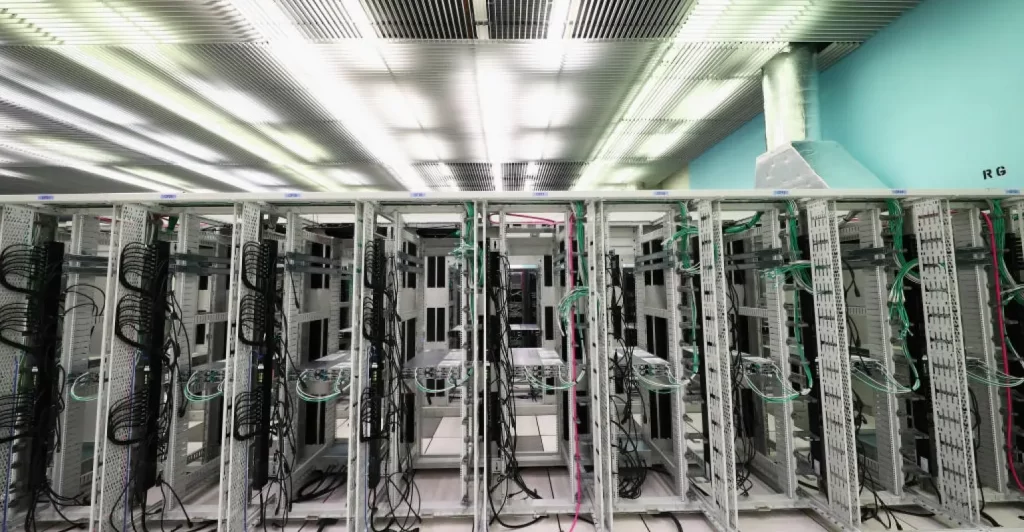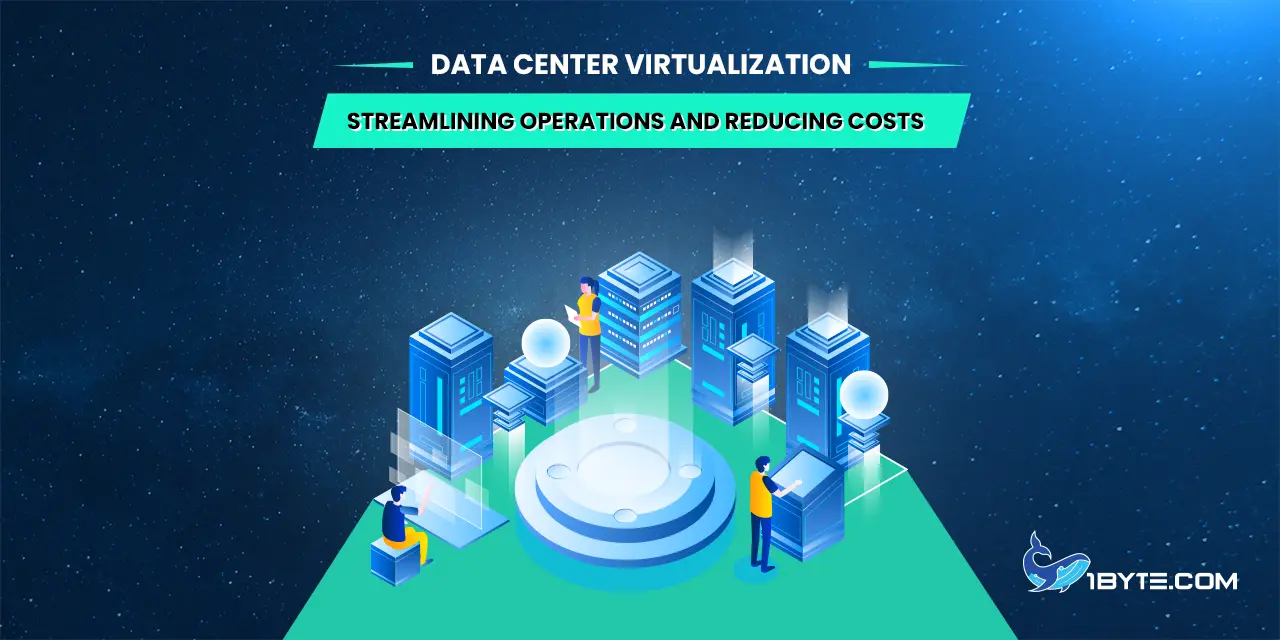Do you want to optimize your data center operations while lowering costs? Data center virtualization could be the answer you’ve been looking for. In this post, we’ll look at the pros and drawbacks of data center virtualization, and how it can help you optimize your operations and save money. So, let’s get started and see how virtualizing your data center may transform your organization!
Understanding Data Center Virtualization
Let’s begin our article by getting a firm grasp of data center virtualization. What does it all mean?
Definition of data center virtualization
Data center virtualization is all about exploiting virtualization technology to optimize your data center operations. In layman’s terms, it entails running virtual replicas of your servers, storage, and networks on a single physical server. This virtualization allows you to combine numerous physical servers into virtual computers, increasing usage and efficiency.
Data center virtualization allows you to free yourself from the constraints of traditional hardware architecture and create a more flexible and scalable environment. You gain better agility in deploying resources and responding to changing business needs by centralizing control and management. The end result? Enhanced operational efficiency, cost savings, and simplified processes. So, harness the potential of data center virtualization to achieve a new level of efficiency and cost-effectiveness.
Data center virtualization right now
The industry for data center virtualization is now enjoying a considerable rise. According to Statista, the worldwide data center virtualization market will earn billions of dollars in revenue between 2021 and 2030. The statistics speak for themselves, demonstrating the increasing use and acknowledgment of the benefits of data center virtualization.
Furthermore, according to Global Market Insights, the Data Center Virtualization Market crossed USD 5 billion in 2021 and is expected to rise at a CAGR of more than 15.5% between 2022 and 2030. These findings show that data center virtualization is on a strong rising trend, as firms around the world grasp its potential for streamlining operations and lowering costs.

The increasing demand for data center virtualization solutions is shown in the increase in market size and revenue. Businesses are adopting this technology in order to optimize their data center architecture, increase resource utilization, and gain a competitive advantage in today’s digital landscape.
With such significant growth projections, it is apparent that data center virtualization is not a passing fad but a disruptive technique that is here to stay. As more businesses recognize the benefits, they are aggressively investing in virtualizing their data centers to improve operational efficiency and reduce costs.
Virtualization technologies and their role in data center virtualization
LVirtualization technologies are critical in data center virtualization, changing resource management and utilization. The hypervisor is an important technology in this field. It serves as a wizard’s wand, allowing the construction and management of virtual machines (VMs) on a single physical server.
The hypervisor abstracts the underlying hardware, allowing several VMs to cohabit and operate independently, each with its own operating system and applications. This means that many operating systems and applications can operate on the same physical server at the same time, enhancing resource usage and flexibility. Storage virtualization is another virtualization method to discuss. It aids in the optimization of storage resources by grouping them together and making them easier to manage and allocate.
Similarly, network virtualization enables the establishment of virtual networks that are independent of the physical network infrastructure, allowing for more efficient utilization of network resources. You may break free from hardware constraints, streamline operations, and achieve a more agile and cost-effective data center environment with these virtualization solutions at your disposal. So, embrace the power of virtualization technologies to realize your data center’s full potential.
Hypervisors and their significance in virtualizing servers
Hypervisors are the data center virtualization’s superheroes, allowing servers to be virtualized and unlocking a world of efficiency. These layers of software or firmware sit between the physical server hardware and the virtual machines (VMs) that run on it. Hypervisors operate as gatekeepers, managing and allocating server resources to VMs. They enable numerous VMs to coexist on a single physical server, each running separately with its own operating system and applications.
Hypervisors’ importance in server virtualization cannot be emphasized. They enable server consolidation, allowing you to run several virtual machines on a single physical server. Because many physical servers are unused, this consolidation helps to maximize resource consumption. With a hypervisor in place, you may better utilize available server resources and minimize the number of physical servers required, lowering hardware procurement and maintenance costs.
Hypervisors are also important for increasing flexibility and scalability. You can swiftly install and expand virtual servers to meet changing workload demands because of their ability to generate and manage VMs. Hypervisors enable the agility to adjust on the fly, whether you need to spin up additional instances or scale down resources.
Finally, hypervisors allow VMs to be moved between physical servers, allowing for workload balancing and maintenance without interfering with operations. Workload mobility flexibility improves availability and reduces downtime.
Recommended reading: Server Virtualization: Benefits and Best Practices
3 Benefits of Streamlining Data Center Operations Through Virtualization
This section will look at how data center virtualization boosts efficiency by maximizing resource utilization and lowering expenses. Prepare to learn about the primary advantages of virtualizing your data center and transform your operations.
Increased server utilization and resource optimization
Virtualization of data centers provides a game-changing advantage: higher server utilization and resource optimization. Traditional data centers are frequently plagued with underutilized servers, with each physical server operating at a fraction of its full capability. Data center virtualization allows you to overcome this inefficiency and maximize the utilization of your server resources.
You can build several virtual machines (VMs) that run on a single physical server by virtualizing your servers. This consolidation allows you to make greater use of the computational resources that are available. Instead of having numerous underutilized servers, you may now host multiple VMs on a single server, each with its own dedicated resources.
The end result? Significant increase in server utilization. You can reach better levels of efficiency with data center virtualization by executing more workloads on fewer physical servers. This not only saves space but also reduces power usage and cooling requirements, resulting in long-term cost benefits.
Furthermore, resource optimization is linked to greater server utilization. With virtualization, you may dynamically distribute resources based on workload demands. CPU, memory, and storage resources can be simply adjusted to meet the needs of each virtual machine. This resource allocation optimization capability ensures that your apps and workloads function smoothly without wasting resources or generating performance bottlenecks.
Simplified management and provisioning
Data center virtualization breathes new life into infrastructure management and provisioning. Managing and supplying resources in traditional data centers can be a time-consuming and complex operation. However, data center virtualization makes things a lot easier.
Virtualization enables you to manage your virtual machines (VMs) and resources from a single location. You get a bird’s-eye perspective of your complete virtualized infrastructure, which makes monitoring and controlling data center operations easier. You can create, deploy, and manage VMs from a single management interface, making resource provisioning a breeze.
This ease of management extends to other areas as well. You may easily clone or duplicate VMs with virtualization, allowing for the quick and efficient deployment of new instances. Do you need to scale up or down? No worries. With a few mouse clicks, you may dynamically distribute or reallocate resources to meet changing demands.

Manual configuration and complex hardware installations are a thing of the past. Many common processes can be automated using data center virtualization, saving time and effort. Virtualization technologies have built-in capabilities that streamline operations and simplify management, such as VM migrations and load balancing.
Lastly, virtualization enables the construction of templates and standardized setups, which provide consistency and reduce the possibility of errors. This simplifies provisioning and allows for the rapid deployment of new apps and services.
Enhanced disaster recovery and business continuity
Data center virtualization improves disaster recovery and business continuity methods in addition to improving operational efficiency and cost savings. Data center virtualization gives the tools and skills required to ensure minimal downtime and speedy recovery in the event of a disaster or system failure.
One of the primary advantages of virtualization is the ability to produce and manage virtual machine (VM) snapshots or replicas. These snapshots act as restore points, capturing a VM’s state at a certain point in time. These snapshots can be used to swiftly restore the VM to a previous operational state in the event of a disaster, decreasing downtime and minimizing data loss.
Virtualization also allows for the replication of virtual machines (VMs) across numerous physical servers or data centers. You may achieve high availability and resilience by maintaining duplicate copies of VMs in multiple places. The workload may automatically failover to the replicated VM in the event of a failure, minimizing the impact on your business operations.
Additionally, data center virtualization makes it easier to create virtual networks and storage systems that are not dependent on physical infrastructure. This decoupling of resources from the underlying hardware facilitates the migration of workloads and data to different sites in the event of a disaster. It helps you to relocate essential applications and services to a different data center fast and efficiently, maintaining business continuity.
Virtualization technologies also include features such as live migration, which allows you to move a running virtual machine from one physical server to another with no downtime. This capability is especially important for planned maintenance activities or load balancing, ensuring that services are available to users at all times.
Recommended reading: Distributed Cloud: Exploring the Future of Cloud Computing
5 Considerations for Successful Data Center Virtualization
In this final section, we will look at the factors you should keep in mind to achieve a successful data center virtualization journey. Understanding these concerns can set you up for success in streamlining operations and lowering costs through data center virtualization, from reviewing your infrastructure to planning for scalability and security. So, let’s look at the key variables that contribute to the effective implementation of data center virtualization.
Assessing workload suitability for virtualization
An important step in the data center virtualization journey is determining the viability of your workloads for virtualization. Not all workloads are created equal, and some may lend themselves better to virtualization than others. You may determine the workloads that will benefit the most from virtualization by carefully examining them.
Begin by examining each workload’s characteristics, such as resource use, performance needs, and dependencies. Virtualization is often appropriate for workloads that are CPU-intensive, memory-intensive, or have predictable resource demands. Workloads with specific hardware needs or those require direct access to actual devices, on the other hand, may be less suited.
Consider your applications’ compatibility with virtualization technologies. Make sure your applications and operating systems are compatible with virtualized environments. In a virtualized environment, some old programs or specialized software may not function optimally or may require additional configuration.
It is also critical to assess the potential performance impact of virtualization. While virtualization has the potential to increase efficiency, it is critical to ensure that the virtualized system can fulfill the performance needs of your applications. Consider latency, I/O performance, and network capacity to guarantee a smooth transition.
Remember to consider the scalability of your workloads. Because virtualization enables variable resource allocation and scaling, investigate whether your workloads would benefit from the ability to adjust resources dynamically based on demand. Scalable workloads with variable resource requirements might benefit tremendously from virtualization.
Finally, think about the risks and challenges of virtualizing specific workloads. Determine any dependencies or limits that may have an impact on the virtualization process. Addressing these issues ahead of time can help to ensure a smoother and more successful implementation.
Proper planning and resource allocation
A successful data center virtualization program requires careful planning and resource allocation. Begin by performing a thorough review of your present infrastructure, which includes servers, storage, and networking components. Examine their storage capacity, performance, and compatibility with virtualization technologies. This evaluation will assist you in identifying any potential bottlenecks or constraints that must be addressed prior to virtualization.
Next, describe your virtualization objectives and goals. Determine which workloads and apps will be virtualized and set clear performance, scalability, and cost-saving benchmarks. This will help you prioritize your virtualization efforts and guide your resource allocation decisions.

Provide enough hardware resources to support your virtualized environment. Consider CPU, memory, storage, and network bandwidth to ensure that each virtual machine has the resources it needs to run efficiently. Proper resource allocation will help you avoid performance difficulties and make the best use of your physical infrastructure.
In addition to hardware resources, make sure you have enough time and people to plan, install, and manage your virtualized system. Virtualization necessitates specialized knowledge and employees to handle duties like configuration, monitoring, and maintenance. To maintain seamless operations, consider educating your IT team or outsourcing to skilled individuals.
Create a solid backup and disaster recovery plan for your virtualized environment. This comprises regular virtual machine backups, replication to offshore sites, and recovery procedure testing. Proper disaster recovery planning will help to limit risks and preserve business continuity in the event of unforeseen catastrophes.
You should also regularly monitor and optimize resource allocation. Evaluate the performance of your virtualized environment on a regular basis and make improvements as needed. This includes finding and reclaiming unused resources for other workloads, as well as scaling resources up or down based on changing demand.
Ensuring security and compliance in virtualized environments
When deploying data center virtualization, it is critical to ensure security and compliance in virtualized environments. Start by putting in place strong access restrictions and authentication measures to protect your virtualized environment. To ensure that only authorized workers may access and manage virtual resources, use strong passwords, two-factor authentication, and role-based access control. To reduce the danger of illegal access, check and adjust access privileges on a regular basis.
Patch and upgrade your virtualization software and hypervisor on a regular basis to address security vulnerabilities and guarantee you have the most recent security features and bug fixes. Keep track of security warnings and deploy updates as soon as possible to reduce the chance of exploitation.
Implement systems for monitoring and auditing to track and analyze actions within your virtualized environment. Keep an eye on network traffic, log files, and system events for any suspicious or illegal activity. Review audit records on a regular basis to discover potential security incidents and take relevant action.
Maintain industry and regulatory standards compliance. Check that your virtualized environment complies with relevant rules such as PCI-DSS, HIPAA, or GDPR. Implement the required controls and processes to safeguard sensitive data, preserve data integrity, and meet reporting requirements.
Conduct security assessments and vulnerability scans on a regular basis to discover any flaws or potential hazards in your virtualized environment. Address detected vulnerabilities as soon as possible and follow best practices for security hardening.
Educate your employees and IT personnel on best practices for security and the particular security implications of virtualized systems. Encourage a security-conscious culture and ensure that everyone understands their responsibility in keeping a secure and compliant virtualized data center.
Training and skill development for IT personnel
When it comes to properly deploying and managing data center virtualization, IT worker training and skill development are critical. The transition to a virtualized environment necessitates the acquisition of new knowledge and expertise that extends beyond traditional IT infrastructure.
Begin by offering comprehensive data center virtualization training sessions that cover the fundamentals. Understanding of virtualization ideas, virtual machine administration, and virtual network setups should be included. Allow IT workers to practice their abilities in a safe setting by providing hands-on training exercises and simulations.
Encourage IT employees to earn data center virtualization certifications. VMware Certified Professional (VCP) and Microsoft Certified: Azure Administrator Associate certifications confirm their knowledge and skills in virtualization technologies. These certifications can help them gain credibility and demonstrate their knowledge of virtualized environments.
Maintain IT personnel’s knowledge of the most recent trends and breakthroughs in data center virtualization. Encourage them to attend trade shows, webinars, and workshops. These conferences offer opportunities to learn from professionals, network with peers, and obtain insights into best practices and upcoming technologies.
You should also consider collaborating with external data center virtualization training providers or consultants. These professionals can provide customized training sessions that are targeted to the specific needs of your firm. They can also offer advice and assistance during the implementation and optimization phases.
Finally, encourage IT workers to take part in cross-functional projects and work with other teams, such as network or storage administrators. This collaboration improves their understanding of the larger context of data center operations and their ability to integrate virtualization with other components.
Monitoring and performance optimization in virtualized setups
Monitoring and performance improvement are critical components of data center virtualization management. First, install reliable monitoring tools that provide real-time visibility into the virtual environment. These technologies aid in the tracking of resource consumption, the identification of bottlenecks, and the detection of any irregularities or performance difficulties. Monitoring indicators such as CPU consumption, memory utilization, network traffic, and storage latency can give useful information about the health and performance of virtualized workloads.
To improve the efficiency of virtualized settings, use performance optimization strategies. Load balancing workloads among physical hosts, improving resource allocation, or modifying virtual machine configurations are all examples of this. You may optimize resource consumption and overall performance by fine-tuning the virtual infrastructure.
Within the virtual environment, monitor and optimize network connectivity. Network performance is crucial in data center virtualization because it connects virtual computers and allows for data transfer. Ensure that network capacity is properly allocated, and keep an eye on network latency and performance to discover any areas for improvement.
Use proactive capacity planning to predict future resource needs. You can foresee the demand for extra resources and plan accordingly by examining past data and growth trends. This prevents performance degradation due to resource constraints and assures smooth operations.
Perform performance testing and benchmarking on a regular basis to evaluate the performance of virtualized workloads. This enables you to find areas for improvement and validate the efficacy of optimization efforts. To acquire accurate and dependable findings, use industry-standard benchmarks and performance testing tools.
Consider using automation and orchestration solutions to help you with monitoring and performance optimization. These technologies can automate normal monitoring chores, generate warnings for significant occurrences, and even dynamically optimize resource allocation. Automation lowers manual work, increases efficiency, and enables proactive virtualized environment management.
FURTHER READING: |
1.Cloud Migration Strategy: A Step-by-Step Guide |
2.Understanding Cloud Infrastructure: The Basics |
3. Public Cloud vs Private Cloud: Which One Should You Choose? |
Leverage 1Byte’s strong cloud computing expertise to boost your business in a big way
1Byte provides complete domain registration services that include dedicated support staff, educated customer care, reasonable costs, as well as a domain price search tool.
Elevate your online security with 1Byte's SSL Service. Unparalleled protection, seamless integration, and peace of mind for your digital journey.
No matter the cloud server package you pick, you can rely on 1Byte for dependability, privacy, security, and a stress-free experience that is essential for successful businesses.
Choosing us as your shared hosting provider allows you to get excellent value for your money while enjoying the same level of quality and functionality as more expensive options.
Through highly flexible programs, 1Byte's cutting-edge cloud hosting gives great solutions to small and medium-sized businesses faster, more securely, and at reduced costs.
Stay ahead of the competition with 1Byte's innovative WordPress hosting services. Our feature-rich plans and unmatched reliability ensure your website stands out and delivers an unforgettable user experience.
As an official AWS Partner, one of our primary responsibilities is to assist businesses in modernizing their operations and make the most of their journeys to the cloud with AWS.
Conclusion
In today’s competitive corporate environment, data center virtualization is no longer an option; it is a requirement. It enables organizations to stay ahead of the competition, generate innovation, and achieve long-term growth. Organizations that embrace data center virtualization may realize the full potential of their IT infrastructure, achieve operational excellence, and pave the way for future success.
So, if you want to streamline your operations, cut expenses, and remain ahead of the competition, it’s time to embrace data center virtualization and unleash its transformative power. Begin your road to a more efficient and cost-effective IT infrastructure right now.

